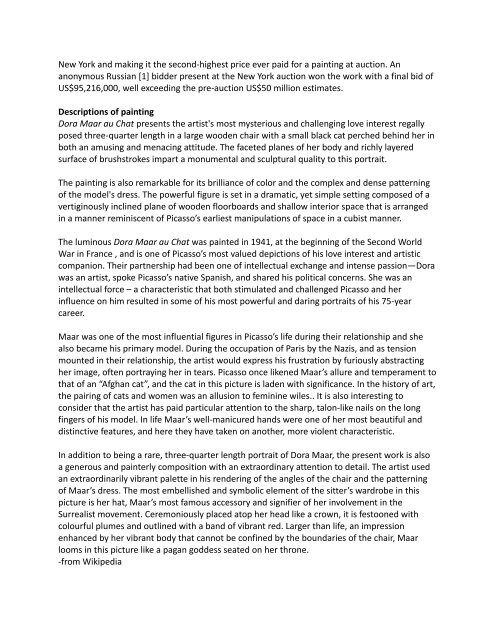Create successful ePaper yourself
Turn your PDF publications into a flip-book with our unique Google optimized e-Paper software.
New York and making it the second-highest price ever paid for a painting at auction. An<br />
anonymous Russian [1] bidder present at the New York auction won the work with a final bid of<br />
US$95,216,000, well exceeding the pre-auction US$50 million estimates.<br />
Descriptions of painting<br />
Dora Maar au Chat presents the artist's most mysterious and challenging love interest regally<br />
posed three-quarter length in a large wooden chair with a small black cat perched behind her in<br />
both an amusing and menacing attitude. The faceted planes of her body and richly layered<br />
surface of brushstrokes impart a monumental and sculptural quality to this portrait.<br />
The painting is also remarkable for its brilliance of color and the complex and dense patterning<br />
of the model's dress. The powerful figure is set in a dramatic, yet simple setting composed of a<br />
vertiginously inclined plane of wooden floorboards and shallow interior space that is arranged<br />
in a manner reminiscent of Picasso’s earliest manipulations of space in a cubist manner.<br />
The luminous Dora Maar au Chat was painted in 1941, at the beginning of the Second World<br />
War in France , and is one of Picasso’s most valued depictions of his love interest and artistic<br />
companion. Their partnership had been one of intellectual exchange and intense passion—Dora<br />
was an artist, spoke Picasso’s native Spanish, and shared his political concerns. She was an<br />
intellectual force – a <strong>character</strong>istic that both stimulated and challenged Picasso and her<br />
influence on him resulted in some of his most powerful and daring por<strong>traits</strong> of his 75-year<br />
career.<br />
Maar was one of the most influential figures in Picasso’s life during their relationship and she<br />
also became his primary model. During the occupation of Paris by the Nazis, and as tension<br />
mounted in their relationship, the artist would express his frustration by furiously abstracting<br />
her image, often portraying her in tears. Picasso once likened Maar’s allure and temperament to<br />
that of an “Afghan cat”, and the cat in this picture is laden with significance. In the history of art,<br />
the pairing of cats and women was an allusion to feminine wiles.. It is also interesting to<br />
consider that the artist has paid particular attention to the sharp, talon-like nails on the long<br />
fingers of his model. In life Maar’s well-manicured hands were one of her most beautiful and<br />
distinctive features, and here they have taken on another, more violent <strong>character</strong>istic.<br />
In addition to being a rare, three-quarter length portrait of Dora Maar, the present work is also<br />
a generous and painterly composition with an extraordinary attention to detail. The artist used<br />
an extraordinarily vibrant palette in his rendering of the angles of the chair and the patterning<br />
of Maar’s dress. The most embellished and symbolic element of the sitter’s wardrobe in this<br />
picture is her hat, Maar’s most famous accessory and signifier of her involvement in the<br />
Surrealist movement. Ceremoniously placed atop her head like a crown, it is festooned with<br />
colourful plumes and outlined with a band of vibrant red. Larger than life, an impression<br />
enhanced by her vibrant body that cannot be confined by the boundaries of the chair, Maar<br />
looms in this picture like a pagan goddess seated on her throne.<br />
-from Wikipedia



